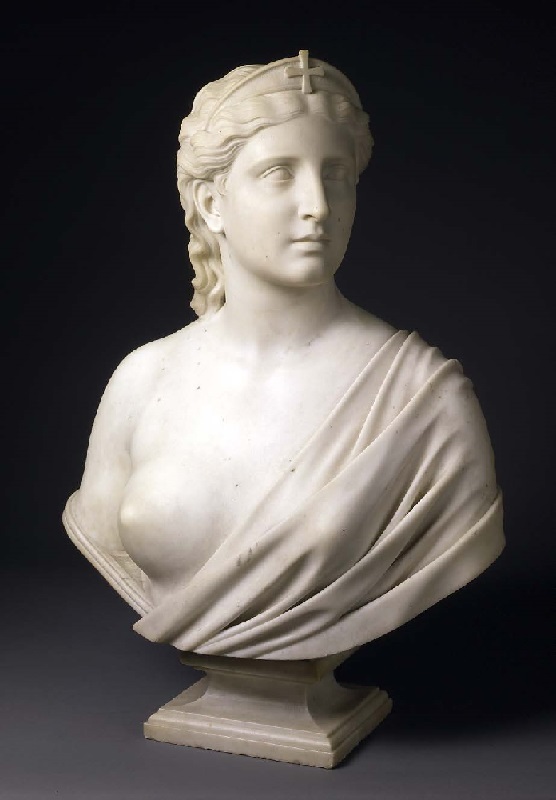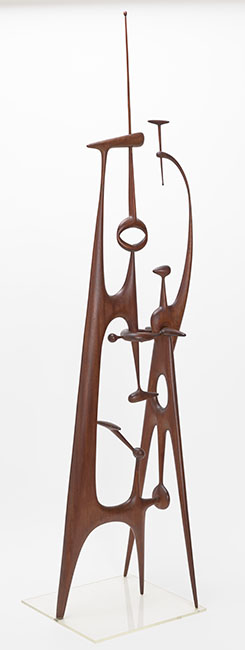One of the best resources for those of us who study American art is undoubtedly the Archives of American Art. Founded in 1954 in Detroit, the institution was originally intended to collect microfilm of archival material relating to American art and artists. It soon shifted, however, beginning to collect original archival materials in addition to continuing to microfilm items borrowed from other institutions and individuals. In 1970 it joined the Smithsonian Institution and relocated to Washington, D.C. Today it holds over 20 million individual items, arguably making it the single most important repository of archival material for researchers on American art.1
Throughout the course of my research into the CFAM collection, it has been rare to find an artist—famous or relatively obscure—who is not represented in the Archives. For those of you who are familiar with archival work, in which a researcher must consult a finding aid for a collection, make an appointment to have the materials pulled from storage, and adhere to a number of rules (no pens, limited or no outside materials, looking at materials only in the reading room) designed to keep the items safe, you may be wondering what use such an institution has been to me in this locked-down time. And the answer to that question lies in the extraordinary digitization efforts the Archives has made over the last fifteen years. With the support of the Terra Foundation, archivists have scanned 230 full collections and an additional 17,000 individual documents, with more being added every day.2 While not every artist represented in CFAM’s collection is represented in the digital collections, many of them are, and that availability has allowed me to do much more research from my home than I would have been able to a decade ago, when I started my doctoral program.

Triumphant Warriors, 1951
Mahogany, 47 x 16 x12 inches
The Alfond Collection of Art and Rollins College, Gift of Barbara ’68
and Theodore ’68 Alfond, 2017.15.13
For example, the Archives includes a document entitled “Declaration by Japanese-American artists, 1941 December 12,” as part of its collection of papers by the painter Yashiro Kuniyoshi.3 Kuniyoshi is not represented in the collection, but one of his co-signers is. The sculptor Leo Amino, whose sculpture Triumphant Warriors forms part of the Alfond Collection, appears on the list of names appended to the end of the brief letter. Issued on December 12, 1941, just five days after the attack on Pearl Harbor, the letter demonstrates that this group of Japanese American artists was immediately aware of the pressures they would face in wartime society, and they wasted no words in denouncing Imperial Japan and the other fascist Axis nations. Unlike many of his colleagues and compatriots living on the West Coast, Amino was not sent to a camp, and would serve as a translator for the United States Navy during World War II. After the war, he was the first American artist to experiment with plastic resin, which had become ubiquitous as wartime needs diverted copper, silk, and other materials away from civilian use.4 Triumphant Warriors is made out of wood rather than plastic, but shows the same attention to natural forms as his work in newer materials, and places him squarely in the group of Abstract Expressionist sculptors active in New York after the Second World War.
In another case, the Archives of American Art sheds significant light on a work in the collection. The sculptor Hiram Powers was undoubtedly the most famous and sought-after American sculptor during the nineteenth century. Living in Florence, near the marble quarries and skilled workers that made his work possible, Powers executed a number of important public commissions and a vast array of portrait busts of wealthy visitors, but his biggest innovation was in idealized portraits, which he turned out in assembly-line fashion for anyone who wished to buy one.5 The painter’s archive, including price lists, correspondence, published material, and photographs of the studio and works, passed down through the sculptor’s family until they were sold to the Archives by his great-granddaughter.6 In contrast to the single document on Amino, the Powers collection is quite large, measuring 12.4 linear feet. Linear feet is a standard measurement for archivists, and refers to the amount of space a collection takes up on a standard shelf. The Powers papers are by no means the largest of the archival collections out there, but 12.4 linear feet is a sizable amount, and it took me several days to go through it all, even focusing only on material related to CFAM’s work, Faith. One of several idealized busts on the subject executed by the artist and sold for $100 (a substantial amount in the 1860s and 1870s), this version was passed to Hiram Powers II, the artist’s grandson and a professor at Rollins, who donated it to the college in 1976.

29 x 29 x 12 in, Gift of Hiram Powers II, grandson of the artist
and Rollins College professor, 1976.31
Going through an artist’s papers is often tedious work. The handwriting, even when it is good, is very different from what we are used to today. And when it was bad, as Powers’ was, it can be a nightmare. Luckily, for this particular collection volunteers at the Smithsonian created transcripts of all the correspondence, which speeded things up considerably (though I made sure to refer to the original letters for any particularly significant findings). Also luckily, Powers kept copies of most of his outgoing correspondence, so a researcher is able to piece together whole conversations carried out by trans-Atlantic mail, often over weeks or even months at a time. A picture of the artist’s personality starts to emerge, and Powers comes across as somewhat touchy, easy to take offense, but also exacting about the standards of quality to which he held his art. It also allows us to see who purchased the other copies of Faith, many of which have ended up in museums around the country.
If you find yourself looking for something to do on a dreary afternoon this spring, I urge you to head on over to the Archives of American Art and do some exploring. It will give you an insight into the world of art historical scholarship, and I bet you’ll learn something fascinating besides! Finally, be on the lookout for Pushing the Envelope: Mail Art from the Archives of American Art. Originally scheduled for this summer, it will appear at CFAM sometime in the coming months.
1“About the Archives of American Art.”
2“Terra Foundation Center for Digital Collections.”
3Yasuo Kuniyoshi. Declaration by Japanese-American artists, 1941 December 12. Yasuo Kuniyoshi papers, 1906-2016. Archives of American Art, Smithsonian Institution.
4 Kara Kelley Hallmark, Encyclopedia of Asian American Artists (Greenwood Publishing Group, 2007), 4–5.
5For an overview of Powers’ career and art, see Richard P. Wunder. Hiram Powers: Vermont Sculptor, 1805-1873. Vol. 1: Life. Newark: University of Delaware Press, 1991.
6Hiram Powers papers, 1819-1953, bulk 1835-1883. Archives of American Art, Smithsonian Institution.


One Reply to “Research Highlights, Part 8: The Archives of American Art”